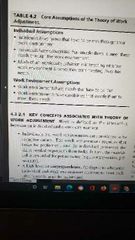![]()
![]()
![]()
Use LEFT and RIGHT arrow keys to navigate between flashcards;
Use UP and DOWN arrow keys to flip the card;
H to show hint;
A reads text to speech;
15 Cards in this Set
- Front
- Back
- 3rd side (hint)
|
TWA Theory of Work Adjustment |
The job must fill the needs of the person and the person must fit the job. Dawis & Lofquist |

|
|
|
Social-cognitive career theory (SCCT) |
Self-efficacy is a person's belief in what he or she is capable of doing, influences career choice. |
|
|
|
Career counseling |
Works within the context of a person's values and attitudes to help him or her acquire self-understanding. |
|
|
|
Person environment correspondence (PEC) |
The relationship between job satisfaction and an increase in productivity. |
|
|
|
John Krumboltz developed what theory? |
Learning Theory of Career Counseling (LTCC). |
|
|
|
What did Krumboltz believe? |
1. He believed that people's learning experience influence their career choice. 2. Career counseling may need to challenge preconceived notions of acceptance career options. |
|
|
|
Linda Gottfredson's theory believed |
Career development process of children and adolescents and how self concept affects vocational choices. She emphasized gender and prestige. |
|
|
|
Tiedman's model believed |
Career counselors should help individuals resolve ego-relevant crises. |
|
|
|
Contextualism |
Believe that career development results from constant interactions between individuals and the environment. |
|
|
|
Who are the key people in career development? |
George Merril, Frank Parson Edmund Williamson Donald Super John Crites John Holland John Krumboltz Joanne Harris Bowlsbey
|
|
|
|
Who developed the career maturity inventory? |
John Crites |
|
|
|
Who introduced the term career adaptability? |
Donald Super |
|
|
|
Circumscription |
Refers to the process in which individuals (children) eliminate career alternatives that are not compatible with self concept. |
|
|
|
Ginzberg Career Development Theory |
Fantasy stage - up to 11 (Ideas about future careers) Tentative stage - 11-17 Realistic stage - 17 - 20s |
|
|
|
Super identified 5 vocational development tasks. |
1. Crystallization 14-18 2. Specification 18-21 3. Implementation 21-14 complete training & enter employment 4. Stabilization 24-35 5. Consolidation 35+ becoming established in career. |
|

